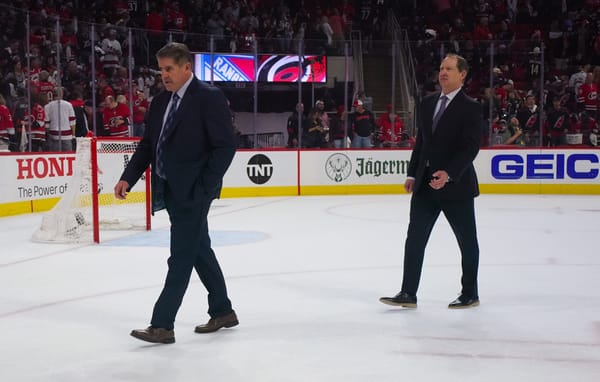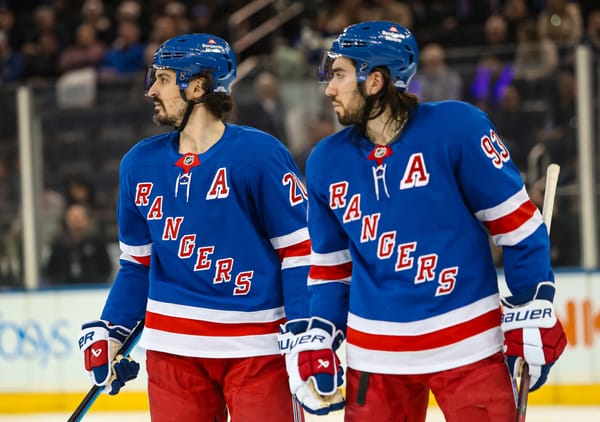Checking in on Alexis Lafrenière
The noted bust might not actually be a bust.
Coming off a strong finish to his 2020-21 rookie campaign, in which he scored five of his 12 goals in the season’s final dozen games, 2020 number-one-overall draft pick Alexis Lafrenière appeared poised to hit the ground running for the New York Rangers this season. Indeed, he notched three goals and an assist in the club’s first eight games, as he was given an early opportunity to play on the top line with Mika Zibanejad and Chris Kreider, albeit on his off-side of right wing.
An Up-and-Down Season for Lafrenière
Soon, however, Lafrenière would be taken off the top line as head coach Gerard Gallant was tinkering with the combinations in what was still the early going. Lafrenière’s production, not coincidentally, began to drop off, as he would tally only two goals (and no assists) in his next 17 games. His production was looking to be no better than what he achieved in his rookie season.
Nevertheless, the 20-year-old Quebec native (let’s remember just how young he still is) maintained an even-keeled and humble attitude, even when he was called out by his head coach early in the season — a move that Lafrenière took in a positive way as a motivator.
“I have to be better,” he said following Gallant’s comment, which came on the heels of a rough 5-1 home loss to the Calgary Flames on Oct. 26. “Last game wasn’t a good game for me. It was a physical game, a tough game, and you’ve got to be able to win your battles one-on-one. It wasn’t good enough for me, so we’ll try to fix some things and get back at it (in the next game).”
Lafrenière kept working hard, all the while spending almost the entirety of the next few months in the bottom six. Gallant finally moved him back to the top line with Zibanejad and Kreider a few months later. Naturally, the points started to come once again. Beginning with a Jan. 30 home win against the Seattle Kraken, Lafrenière scored five goals and one assist over a nine-game stretch. After a mild lull in scoring for a handful of contests, Lafrenière proceeded to put together a six-game point strength — the longest of his young career so far — tallying two goals and five assists in the six games from March 17 through March 27. His playmaking ability has begun to shine through.
Interestingly, Lafrenière’s first season with Rimouski Océanic in the QMJHL – when he was only 16 years old — saw him score more goals than assists (42 and 38, respectively, in 60 games), as he has done to this point in his early NHL career. In his last two junior seasons, however, he emerged as much more of a playmaker. In his age-17 season, he tallied 37 goals and 68 assists in 61 games, and then followed that up with 35 goals and 77 assists in just 52 games in his age-18 season.
His Rangers career has thus far highlighted more of his goal-scoring abilities than his playmaking, but his increased confidence and increased ice time with more skilled players could be what unlocks his playmaking talents at the NHL level. During his aforementioned six-game point streak, quickly doubled his full-season assist total from five to 10. None of this is to mention how many more assists he’d have if some of his regular linemates from earlier in the season (e.g., Julien Gauthier) had better finishing ability.
More recently, coinciding with the Rangers’ various trade deadline acquisitions, Lafrenière has found himself back on the third line, but on his more natural left wing, as Gallant works with additional options up front. While Lafrenière is no longer getting ice time with players as productive as Kreider and Zibanejad, the Rangers’ newfound depth upfront should afford him more opportunities to continue to hone his craft with players who better complement his skill set versus what he’s seen for the better part of his career to this point. That and a more confident Lafrenière from his recent experiences could help give the Rangers a deep, balanced attack that will make them much more dangerous in the postseason.
Lafrenière in a Unique Situation
Still, there might be some fans who expect much more overall production from a number-one draft pick. After all, Lafrenière still only has 15 goals and 10 assists in 67 games this season. A more granular recency bias would not be kind to him either, as he has picked up zero points in his last three games, the latest of which was a 3-0 loss to the New York Islanders in which he (and the entire team, to be fair) looked very flat.
On the surface, the question of why a highly-touted number-one draft pick is not scoring more seems to have merit. But Lafrenière is in a unique situation on this Rangers team. Most teams that land a number-one draft pick are cellar dwellers without much, if any, top-tier talent. The Rangers were awarded the number-one draft pick thanks to a one-time-only draft lottery process that was a result of the COVID-shortened 2019-20 season — and yes, some luck as well. When that season was cut short, the Rangers were a fringe playoff team, with established stars up front (e.g., Zibanejad and Artemiy Panarin), and depth at Lafrenière’s left wing position in Panarin and Chris Kreider.
The Rangers did the right thing in taking the consensus best player available at the time, but there was no room to slot him onto the top line immediately if he was to maintain his natural position. The Blueshirts also did not need to, and still do not need to, lean on him to be THE guy. It’s more common for a number-one draft pick to find himself being counted on much more quickly to be one of his team’s top producers; Jack Hughes, who is having a fantastic third season with the New Jersey Devils, is a great recent example of that. While having a number of other players to carry them is good for the Rangers, it’s not going to help Lafrenière’s point production.
Tying to this is Lafrenière’s lack of power-play ice time. Most of the best players in the league play well at even strength, but dramatically boost their overall point totals on the power play. The Rangers have an elite top power-play unit that does not include Lafrenière (it includes Zibanejad, Kreider, Panarin, Adam Fox, and Ryan Strome), and there’s no reason for them to mess with it. Lafrenière is a mainstay on the second unit, but most of that group’s power-play ice time comes with around 30 seconds remaining in a power play, when the puck has been cleared to elicit a line change. By the time that group potentially establishes possession in the offensive zone, the power play is just about over.
While not his fault and not even something for which the Rangers, with their potent top power-play unit, should be blamed, the fact remains that compared to a number of other recent number-one picks, Lafrenière has simply not had the same man-advantage opportunities to pad his stats.
thru first 76 GP:
— HockeyStatMiner (@HockeyStatMiner) November 30, 2021
PP TOI/game ranking among forward teammates (minimum 30 GP)
1st Ovechkin
2nd Crosby
1st Kane
7th Stamkos
3rd Tavares
4th Hall
2nd Nugent-Hopkins
6th Yakupov
6th MacKinnon
1st McDavid
1st Matthews
4th Hischier
2nd Hughes
6th Lafreniere https://t.co/bulCHvNX3K
Strong Play at Even Strength
Incredibly, he only just recently nabbed his first career power-play point on March 17, with an assist against the Islanders. As bad and unlucky as that is, context matters. With the context around Lafrenière’s lack of power-play opportunities now established, let’s shift back to his five-on-five play — even though, as mentioned, that has also had its share of circumstantial limitations for large swaths of the youngster’s first two seasons. In any event, his five-on-five statistics paint a much more promising and, I daresay, more telling picture of what kind of player Lafrenière is and will be.
Guess who leads the Rangers in five-on-five goals scored over the past two seasons (i.e., the entirety of Lafrenière’s NHL career)? Not Kreider. Not Zibanejad. Not Panarin. It’s Lafrenière, with 26. (Kreider, who does so much damage on the power play, has 25.) And that’s in less ice time than Kreider, Zibanejad, Panarin, and Strome.
Lafrenière also compares favorably with other recent top draft picks and top players in even-strength scoring metrics (thank you, @HockeyStatMiner):
even-strength points thru first 82 NHL games:
— HockeyStatMiner (@HockeyStatMiner) December 11, 2021
29 - Stamkos
29 - Tavares
29 - Lafreniere
just to be clear: Lafreniere hit 25 career 5v5 goals before Hall, Hughes, Kane, MacKinnon, NugentHopkins, Stamkos, or Tavares got to 20
— HockeyStatMiner (@HockeyStatMiner) March 3, 2022
5v5 goals through first 101 NHL games:
— HockeyStatMiner (@HockeyStatMiner) February 2, 2022
38 - Matthews
27 - Crosby
24 - McDavid
21 - Lafreniere
20 - Hischier
18 - Stamkos
17 - Kane, MacKinnon
16 - Hall, Yakupov
15 - NugentHopkins
13 - Tavares
10 - Hughes
Only 16 players in the league have more 5v5 goals in the past calendar year than Alexis Lafreniere
— HockeyStatMiner (@HockeyStatMiner) February 28, 2022
Alexis Lafreniere is averaging 1.45 primary points p/hour at 5v5 here in his DY+2 season.
— HockeyStatMiner (@HockeyStatMiner) January 13, 2022
Is that in the McDavid/Matthews tier? No, sadly, it is not.
Is it in the MacKinnon/Hall tier? Yes. It is precisely in that tier, actually.
OK, that’s enough Tweets for now. What about Lafrenière’s underlying impact? Well, the Rangers’ five-on-five offense this season, in terms of expected goals for (xGF), is slightly below league average when he’s on the ice.
That’s not great, but the Rangers as a whole have struggled at five-on-five for most of the season, particularly prior to their trade deadline pickups. What’s more illuminating here is that the team is considerably less dangerous without Lafrenière on the ice.
For a team that needs to find consistency at even strength, Lafrenière represents someone who can help spark offense, even if he is not the main player on whom the Rangers lean. He can help the Rangers as a depth player for now, and his production in relatively limited opportunities (especially compared to other top draft picks) points to a strong possibility of him eventually becoming that star player on whom the Rangers will rely heavily.
Lafrenière is only 20 years old, and he will still experience his share of ups and downs, because development is not linear. But the recent uptick in his play is very promising. That combined with the context of his unique situation should quell any “bust” narratives that might still be swirling around him.





